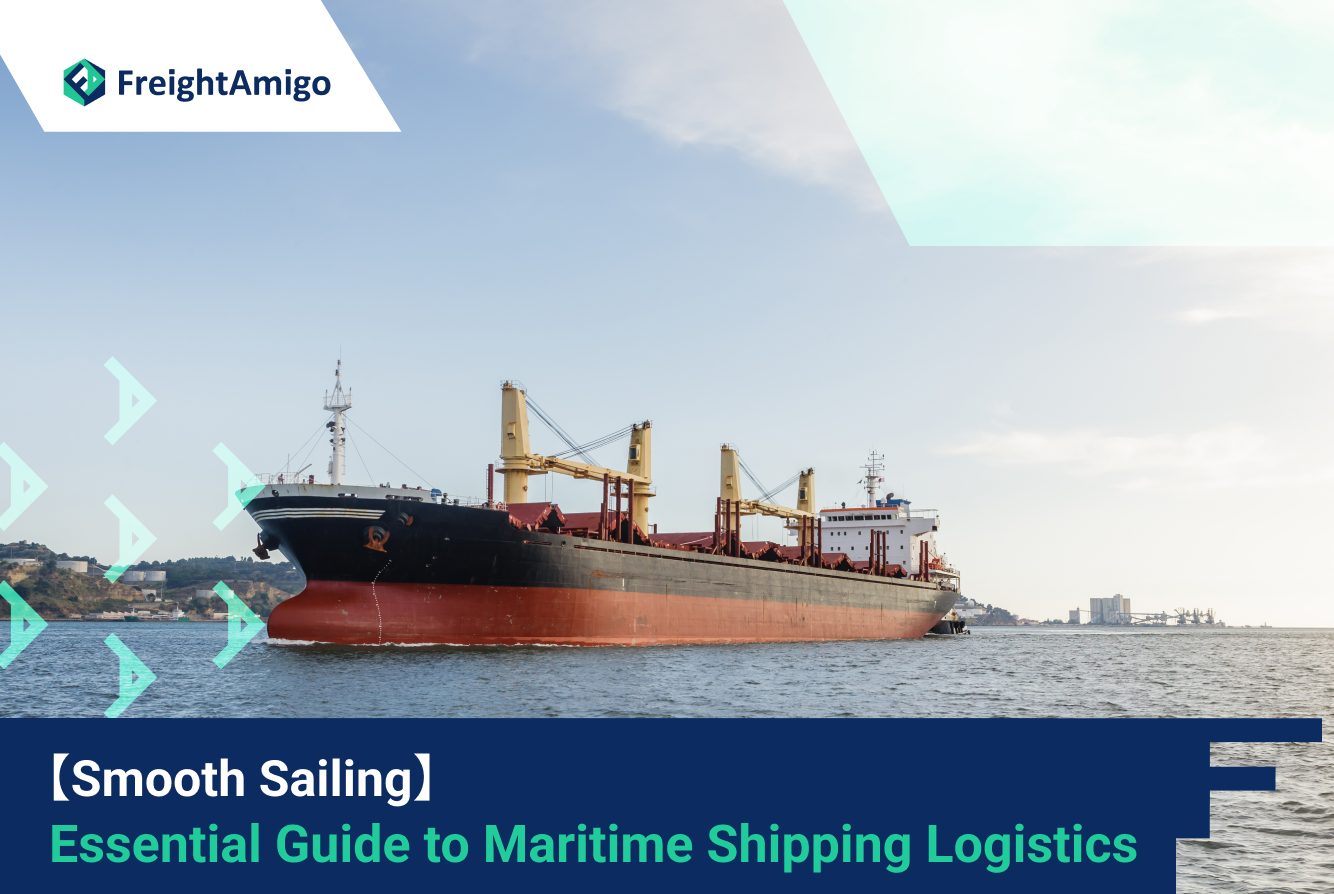Author Name: Tiffany Lee – Marketing Analyst at FreightAmigo
Introduction to Maritime Shipping Logistics
Maritime shipping plays a vital role in facilitating global trade, connecting countries and continents through efficient transportation of goods. Understanding the intricacies of maritime shipping logistics is essential for businesses and individuals involved in international trade. This comprehensive guide aims to provide insights into the world of maritime shipping logistics, highlighting its importance, different modes of transportation, the role of ports and terminals, emerging technologies, sustainable practices, and future trends.
Want To Compare The Best Express, Air Freight, Sea Freight, Rail Freight & Trucking Rates So As To Have Better Control On Cost?
The Importance of Maritime Shipping in Global Trade
Maritime shipping is the lifeblood of global trade, accounting for over 80% of the world’s trade volume. It enables the movement of various goods, including raw materials, finished products, and commodities, across vast distances efficiently and cost-effectively. The accessibility and affordability of maritime transport have facilitated the growth of international trade, allowing businesses to expand their markets and consumers to access a wide range of products from different parts of the world. Without maritime shipping, the global economy would come to a standstill, with severe implications for industries, supply chains, and consumers worldwide.
Types of Maritime Transportation
Maritime transportation encompasses various modes, each serving specific purposes based on the nature of the cargo and the distance to be covered. The two primary types of maritime transport are liner shipping and tramp shipping. Liner shipping operates on fixed schedules, following established routes and offering regular services to transport containerized cargo. Tramp shipping, on the other hand, involves irregular routes and schedules, catering to bulk cargo, such as oil, coal, and grain. Additionally, roll-on/roll-off (RoRo) vessels specialize in carrying wheeled cargo, including cars and trucks, while tankers transport liquid goods, such as petroleum and chemicals. Understanding the different types of maritime transportation enables businesses to choose the most suitable option for their specific needs.
The Role of Ports and Terminals in Maritime Logistics
Ports and terminals serve as crucial nodes in the maritime shipping network, facilitating the loading, unloading, and transshipment of cargo. They act as gateways, connecting land and sea transportation, and play a vital role in ensuring the smooth flow of goods. Ports are equipped with various infrastructure and facilities, including docks, cranes, warehouses, and storage yards, to handle different types of cargo efficiently. Terminal operations involve coordinating numerous activities, such as cargo handling, customs clearance, documentation, and security. Efficient port and terminal operations are essential to minimize delays, optimize cargo flow, and enhance overall supply chain performance.
Emerging Technologies in Maritime Transport
Advancements in technology have revolutionized maritime transport, enhancing efficiency, safety, and sustainability. One notable innovation is the use of autonomous vessels, which have the potential to improve operational efficiency and reduce the risk of human error. These unmanned ships can navigate autonomously, guided by advanced sensors, artificial intelligence, and satellite systems. Additionally, blockchain technology has gained traction in the maritime industry, enabling secure and transparent documentation, tracking, and verification of cargo movements. Other emerging technologies include smart containers equipped with sensors to monitor cargo conditions, drones for aerial surveillance and delivery, and data analytics platforms for predictive maintenance and optimization.
Sustainable Practices in Maritime Shipping
As the global focus on sustainability intensifies, the maritime shipping industry is adopting various measures to minimize its environmental impact. One significant initiative is the reduction of emissions by transitioning to cleaner fuels and energy sources. The International Maritime Organization (IMO) has introduced stricter regulations to limit sulfur emissions and promote the use of low-carbon alternatives. Additionally, efforts are being made to optimize vessel design and operations to enhance fuel efficiency. Another sustainable practice is the implementation of ballast water management systems, which prevent the spread of invasive species during ballasting operations. The adoption of sustainable practices in maritime shipping is crucial to protect the marine environment and contribute to a greener future.
The Future of Maritime Shipping Logistics
The future of maritime shipping logistics holds exciting possibilities driven by technological advancements, changing trade patterns, and environmental considerations. The increasing use of digital technologies, automation, and artificial intelligence is expected to revolutionize various aspects of maritime transport, including vessel operations, cargo handling, and supply chain management. The emergence of alternative fuels, such as hydrogen and ammonia, may revolutionize the industry’s energy landscape. Furthermore, the growing awareness of climate change and sustainability is likely to drive further innovation in green shipping practices. As the industry evolves, businesses and stakeholders must stay abreast of these developments to leverage opportunities and navigate the ever-changing maritime landscape.
Conclusion
Maritime shipping logistics is a complex and critical component of global trade. This comprehensive guide has explored various aspects of maritime shipping, from its importance in facilitating international trade to the role of ports and terminals, emerging technologies, sustainable practices, and future trends. As businesses and individuals engage in maritime shipping, understanding these dynamics is crucial for optimizing supply chains, minimizing costs, and embracing sustainable practices. By staying informed and adapting to the evolving landscape, stakeholders can ensure smooth sailing in the world of maritime shipping logistics.
There Are Different Options For Cargo Transportation. If You Want To Choose The Most Convenient And Suitable Solution, It Is Best To Have The Full Support Of Logistics Experts! If You Are Planning To Ship Goods Overseas, Please Go To The FreightAmigo Page For Inquiries.
===
Read More:
【Logistics News】Singapore to Sign Declaration on Green Shipping Corridors
FreightAmigo Won Startup Grand Award In TechChallenge — Digitising Trade Finance
Sailing Schedule: Streamlining Logistics Operations for Efficient Shipments
===
If you have any inquiries on logistics/supply chain, feel free to contact FreightAmigo now:
Chat with us online OR
Phone : +852 28121686
WhatsApp: +852 27467829









































